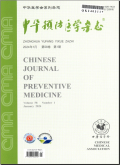柠檬酸镱诱导肝癌细胞HepG2凋亡作用及蛋白质表达变化研究
A differential proteomic study on the influence of ytterbium citrate on HepG2 cells
摘要目的 研究稀土配合物柠檬酸镱([YbCit2]3-)诱导人肝癌HepG2细胞株凋亡的作用及其机制.方法 用DMEM培养基培养人肝癌细胞株HepG2细胞,以DMEM无血清培养细胞为对照组,以0.01~5.00 mmol/L[YbCit2]3-无血清培养基培养组为处理组,应用四噻唑蓝(MTT)法检测[YbCit2]3-对HepG2细胞生长的影响;以2.00 mmoL/L[YbCit2]3-无血清培养基培养组为处理组,Hoechst 33258染色法考察[YbCit2]3-对细胞的作用,采用差异蛋白质组学及H2O2、线粒体膜电位检测的方法研究[YbCit2]3-对HepG2细胞作用的可能机制.结果 2.00~5.00 mmol/L浓度范围内处理72 h,[YbCit2]3-能抑制HepG2细胞的生长,半数抑制浓度(IC50)值为(2.46 ±0.23)mmol/L.2.00 mmol/L[YbCit2]3-处理HepG2细胞48、72 h,Hoechst 33258染色检测表明其作用是诱导HepG2细胞凋亡.HepG2细胞经2.00 mmol/L[YbCit2]3-处理72 h后,通过双向电泳分离和质谱鉴定,鉴定出14个差异表达蛋白质点,包括丝切蛋白1、过氧化物氧化还原酶6、S100钙结合蛋白A6、蛋白酶26s非ATP酶亚基13亚型3等在细胞中分别参与抗凋亡、氧化还原、细胞增殖、蛋白降解等过程的蛋白质.2.00 mmol/L[YbCit2]3-分别作用HepG2细胞24、48 h后,细胞线粒体膜电位检测红绿荧光比值对照组为2.45 ±0.28,24 h组为1.56 ±0.23,48 h组为1.16 ±0.18,与对照组比,差异具有统计学意义(F=23.97,P=0.001);胞内H2O2检测荧光强度对照组为20.00 ±2.08,24 h组为40.00 ±5.50,48 h组为48.00±2.03,与对照组相比,差异具有统计学意义(F=48.40,P=0.000),表明[YbCit2]3-作用后线粒体膜电位下降,H2O2产生增加.结论 [YbCit2]3-可通过调节胞内氧化应激水平和线粒体凋亡途径诱导HepG2癌细胞凋亡.
更多相关知识
abstractsObjective To explore the effects of ytterbium citrate on human liver carcinoma HepG2 cell line and the potential mechanisms.Methotis The HepG2 cells were cultured with DMEM medium and divided into different groups in the following media,in serum-free medium as control,different concentration (0.01-5.00 mmol/L)[YbCit2]3-+serum-free medium as treatment group,MTT assay was used to measure the viability of the cells;2.00 mmol/L[YbCit2]3- +serum-free medium was used as treatment group,and Hoechst 33258 staining was used to detect apoptosis in HepG2 cells.Differential proteomic analysis.assay of intrueellular H2O2 levels and mitochondrial transmembrane petential were performed to study the effects of [YbCit2]3- on HepG2 cells and the potential mechanisms.Results The data showed that 72 h treatment of [YbCit2]3- at 2.00-5.00 mmol/L significantly inhibited cell proliferation,and the IC50 was(2.46±0.23) mmol/L.After treatment with 2.00 mmol/L [YbCit2]3- for 48 h and 72 h,Hoechst 33258 staining demonstrated that [YbCit2]3- induced significantly increased apoptosis in HepG2 cells.After treatment with 2.00 mmol/L[YbCit2]3- for 72 h,two dimensional gel electrophoresis and MALDI-TOF mass spectrometry analysis revealed 14 differentially expressed proteins between [YbCit2]3- -treated cells and the control cells. These proteins mainly included cofilinl, peroxiredoxin6, S100 calcium-hinding protein A6 ,and proteasome 265 non-ATPase subunit 13 isoform 3 and so on. These proteins played important roles in the processes of anti-apoptosis, oxidation reduction, cell proliferation and protein degradation. The mitochondrial membrane potential were investigated, the results showed the ted and green fluorescence ratio was 2.45 ± 0. 28 in the control group,1.56 ± 0. 23 in 24 h group,1. 16± 0. 18 in 48 h group,compared with the control, the differences were significant ( F = 23.97, P = 0. 001 ). The results of H2O2 detection showed the fluorescence intensity was 20. 00 ± 2. 08 in the control group,40. 00 ± 5.50 in 24 h group,and 48.00 ± 2. 03 in 48 h group,compared with the control, the differences were significant ( F = 48. 40, P =0. 000). The results indicated a significant reduction in mitochondrial transmembrane potential and significant increase in H2O2 generation were observed in [ YbCit2 ]3- -treated cells. Conclusion These results suggested that [ YbCit2 ] 3 - could induce apoptosis of HepG2 cells through the mechanisms involving oxidative stress and mitochondrial dysfunction.
More相关知识
- 浏览339
- 被引2
- 下载4


相似文献
- 中文期刊
- 外文期刊
- 学位论文
- 会议论文



 换一批
换一批 换一批
换一批



